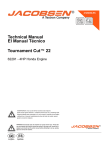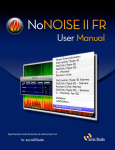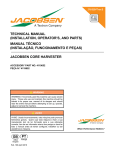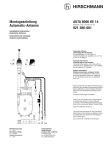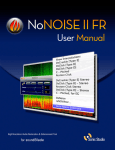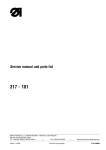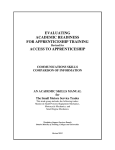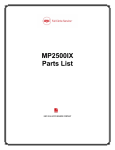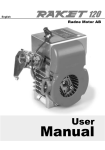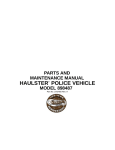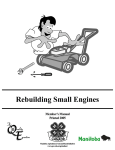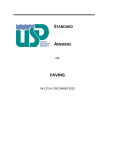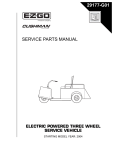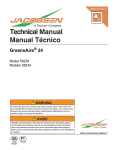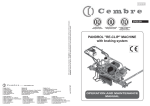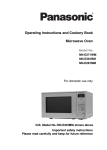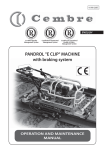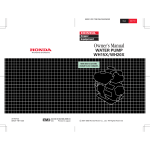Download Bluebird SC550
Transcript
Operator’s Manual MANUAL NO. 539113456 REV. IR (01/16/06) Model: SC550A/968999351 ©2006 BlueBird International. All Rights Reserved. Printed Beatrice, Nebraska 2 TABLE OF CONTENTS Sod Cutter 550A Table of Contents ...................................... 3 Introduction ................................................ 5 Congratulations ..................................... 5 Use ........................................................ 5 Insure your machine .............................. 5 Good service ......................................... 5 Serial number ........................................ 5 Symbols and decals ................................... 6 Safety instructions ..................................... 7 General use ........................................... 7 Preparation ............................................ 9 Operation ............................................... 11 Movement/Transport .............................. 13 Storage .................................................. 13 Children ................................................. 13 Fuel System .......................................... 14 Maintenance .......................................... 15 Customer Responsibility ....................... 16 Protective Equipment ............................... 17 Personal Equipment .............................. 17 Set-Up ......................................................... 18 Equipment set-up .................................. 18 Controls ...................................................... 20 Presentation .......................................... 20 Main Components and Operating Instructions ........................... 20 Engine ................................................... 21 Cutting Unit ............................................ 21 Operation .................................................... 27 Starting the Engine................................. 27 Operating on Hills .................................. 29 Transport ............................................... 29 Maintenance ............................................... 30 Maintenance Schedule ........................... 30 Replacing the Air Filter ............................ 31 Cleaning the Sludge Reservoir ............... 32 Ignition System ....................................... 33 Adjusting the Drive Belt .......................... 34 Blade Wear ............................................ 34 Blade Replacement ................................ 35 Chain Tension Adjust .............................. 35 Chain Replacement ................................ 35 Two Minute Rule ..................................... 35 Cleaning & Washing ............................... 35 Lubrication ................................................. 36 Lubrication Schedule .............................. 36 Lubricating the Chains ............................ 38 Torque Chart .............................................. 38 Troubleshooting ........................................ 39 Storage ....................................................... 42 Winter Storage ....................................... 42 Service ................................................... 42 Technical Data ............................................ 43 Service Journal .......................................... 44 Delivery Service ..................................... 44 After the First 20 Hours .......................... 44 3 WARNING! Failure to follow cautious operating practices can result in serious injury to the operator or other persons. The owner must understand these instructions, and must allow only trained persons who understand these instructions to operate the mower. Each person operating the mower must be of sound mind and body and must not be under the influence of any mind altering substance. WARNING! Engine exhaust, some of its constituents, and certain vehicle components contain or emit chemicals known to the State of California to cause cancer and birth defects or other reproductive harm. 4 INTRODUCTION Congratulations Thank you for purchasing a BlueBird sod cutter. Through your confidence in us, you have chosen an exceptionally high quality product. This manual is a valuable document. It describes your new BlueBird machine. Read the manual carefully before attempting to use the machine. Following the instructions (use, service, maintenance, etc.) can considerably increase the life-span of your machine and even increase its resale value. Please contact your dealer for more information. If you sell your BlueBird machine, make sure to give the operator’s manual to the new owner. Use The sod cutter is used to remove the top layer of sod in a 18” wide strip. Insure your machine Contact your insurance company to check on insurance coverage for your new machine. You should have all-inclusive insurance for liability, fire, damage and theft. Good service BlueBird’s products are sold all over the world and only in specialized retail trade with complete service. This ensures that you as a customer receive only the best support and service. Before the machine was delivered it underwent inspection and was adjusted by your dealer. When you need spare parts or support in service questions, guarantee issues, etc., please consult the following professional: This Operator’s Manual belongs to machine with serial number: Engine number: Serial number The serial number can be found on the printed plate attached to the frame on the back panel under shifter bracket. The plate includes the following information: • • The machine’s type designation (MODEL). The machine’s serial number (S/N). Please state the type designation and serial number when ordering spare parts. The engine’s serial number is punched in the crankcase under the oil level guard. The engine type is specified on the crankcase to the right of the oil level guard but also appears on the decal on the starter. Please state these when ordering spare engine parts. 5 SYMBOLS AND DECALS IMPORTANT INFORMATION WARNING! Xxxx xxx xxxx xx xxxx x xxxx. Xxxx xxx xxxx xx xxxx x xxxx. Used in this publication to notify the reader of a risk Used in this publication to notify the reader of a risk of material damage. of personal injury, particularly if the reader DOES NOT follow the instructions given in the manual. Decals and machine-bound instructions 5 3 6 8 7 4 2 1 Decals that are missing or illegible should be replaced before using the machine. 1. BlueBird logo 5. Maxium RPM 2. BlueBird logo 6. Depth of cut 3. Severing Foot Warning 7. Shift decal 4. Exhaust warnings 8. Operation 6 SAFETY INSTRUCTIONS General use WARNING! The sod cutter can be dangerous if used improperly or with out due care and can lead to serious accidents, in the worst cases even fatal accidents. It is very important that the operator read, understand and follow this operator’s manual and understand the instructions before you attempt to use the machine. These safety instructions only address the basics for safe use. It would be impossible in the safety instructions to describe all possible risk situations that could arise when using the machine. You can, however, prevent accidents by always using common sense. To obtain extra copies of the operator’s manual, please contact your dealer. Read the operating and service instruction manual carefully. Be throroughly familiar with the controls and the proper use of the equipment. Know how to stop the unit and disengage the controls quickly. WARNING! This symbol means that important safety instructions need to be emphasized. It concerns your safety. WARNING! IMPORTANT INFORMATION Do not use the machine until you have read the operator’s manual carefully and understand and follow the instructions given. Failure to follow these safety instructions could result in serious injury or death. All maintenance work or adjustments not described in this manual must be performed by an authorized BlueBird service workshop. The object of this manual is to help you use your BlueBird machine safely and to give you information about how to maintain your machine. Please read the manual carefully before attempting to use the machine. Under no circumstances may the original design of the machine be modified without written approval from the manufacturer. Such modifications not only affect the performance and durability of the machine but may even pose a safety risk for users and those in the vicinity. Unauthorized modifications to the design of the machine may absolve the manufacturer from liability for any resulting personal injury or property damage. Modifying the machine without written approval from the manufacturer will void the warranty. If after reading the operator’s manual you are still unsure about the safety risks associated with use of the machine, you should not use the machine. Please contact your dealer for more information. 7 SAFETY INSTRUCTIONS • Read, follow and understand all safety instructions before using the machine. Failure to do so may result in injury to yourself or others. • Accident prevention regulations, other general safety regulations, occupational safety rules and traffic regulations must be followed without fail. • Only allow responsible adults, who are familiar with the instructions, to operate the machine. • Engage an authorized BlueBird dealer for all service and repairs not described in this manual. • BlueBird original spare parts are designed and specified to maintain high quality and correct fit for optimal durability and life-span. From a safety point of view, you should only use BlueBird original spare parts. • Only use the machine for removing sod. It is not intended for any other use. • Check that the machine is in serviceable condition prior to use; see the chapter ”Maintenance/Maintenance schedule”. • Only use the machine in daylight or in other welllit conditions. Keep the machine a safe distance from holes or other irregularities in the ground. Pay attention to other possible risks. • People and animals can distract you, causing you to lose control of the machine. For this reason, you should always concentrate and focus on the task at hand. • Never leave the machine unsupervised with the engine running. • 8 The machine is tested and approved only with the equipment originally provided or recommended by the manufacturer. WARNING! The engine can become very hot. To avoid being burned, you must turn off the engine and wait until all parts have cooled before touching the engine. WARNING! Overexposure to vibration may lead to circulatory or nerve damage, particularly in people who have impaired circulation. Contact your doctor if you experience symptoms that could have been caused by overexposure to vibration. Examples of common symptoms include numbness, pain, muscle weakness, change of skin color or an uncomfortable feeling of tingling. These symptoms appear most frequently in the fingers, hands or wrists. IMPORTANT INFORMATION Never use a sod cutter that is damaged or incorrectly adjusted. Never use the sod cutter if any component is missing or if it is not properly assembled. If you find yourself in a situation where you are not sure what to do, always seek expert assistance. DO NOT try to resolve any problem you are not qualified to repair. WARNING! Engine exhaust and certain vehicle components contain or emit chemicals considered to cause cancer, birth defects, or other reproductive system damage. The engine exhaust contains carbon monoxide, which is a odorless, colorless, poisonous gas. Do not use the machine in enclosed spaces. SAFETY INSTRUCTIONS Preparations • Make sure that you always have first aid equipment at hand when using the machine. • Make sure nobody else is in the vicinity of the machine when you start the engine, engage the drive or run the machine. • Keep the area of operation clear of all persons, particularly small children, and pets. • Keep in mind that the operator or user is responsible for accidents or hazards occurring to other people, their property, and themselves. • Thoroughly inspect the area where the equipment is to be used and remove all foreign objects. • Find and locate all fixed objects in the ground, such as sprinkler systems, poles, water valves, bases for washing lines, etc. Be certain to check for hidden electrical cables or similar in the surface of the lawn. Always run the machine around these objects. Never intentionally run the machine over foreign objects. • Check that the throttle grip and all guards are fitted and functioning. DO NOT use the machine if it is not working properly. • Makes sure no clothing, long hair or jewelry can catch in moving machine parts. • Check that all safety decals are in place. • Do not operate the equipment without wearing adequate outer garments. Wear protective footwear that will improve footing on slippery surfaces. • Never attempt to make any adjustments while the engine (motor) is running (except where specifically recommended by the manufacturer). • Shift into neutral before starting the engine (motor). 8011-198 Clear the work area before beginning work. 9 SAFETY INSTRUCTIONS WARNING! Always use approved personal protective equipment (as shown in illustration) when using the machine. Protective clothing and protective equipment cannot eliminate the risk of accidents, but wearing proper clothing and the correct equipment will reduce the degree of injury should an accident occur. Ask your dealer about approved protective clothing and approved protective equipment recommended by BlueBird. • • Make sure that you have first aid equipment close at hand when using the machine. Never use the machine when barefoot. Always wear protective shoes or boots, preferably with steel toecaps. 8011-670 Use appropriate equipment. 1. Ear protection • Always wear approved protective glasses or full visor when assembling or cutting sod. 2. Protective glasses • Always wear gloves when handling the blades. 4. First aid kit • Never wear loose clothing that can get caught in moving parts. 5. Protective boots or steel-toed shoes • Use ear protectors to avoid damage to hearing. 10 3. Protective gloves SAFETY INSTRUCTIONS Operating • DO NOT use the machine on grades of more than 25%. • DO NOT use the machine if you are tired, if you have consumed alcohol, or if you are taking other drugs or medication that can affect your vision, judgment or coordination. • Never use the machine indoors or in spaces lacking proper ventilation. • Make sure you have a proper foothold when using the machine, particularly when backing. Walk, don’t run. Never work on wet grass. Poor traction may cause you to slip. • Do not put hands or feet near or under moving or rotating parts. • Smoking, open flames or sparks in the vicinity of the machine are strictly forbidden. Gasoline is extremely flammable and carelessness in handling can result in personal injury or fire. • Never refuel the machine in a building or enclosed trailer. • Never use a machine with a defective muffler. • This machine was designed for sod cutting only. It is not intended for any other use. • After striking a foreign object, stop the engine (motor), remove the wire from the spark plug, thoroughly inspect the machine for any damage, and repair the damage before restarting and operating the machine. • Exercise extreme caution when operating on or crossing gravel drives, walks, or roads. Stay alert for hidden hazards or traffic. Do not carry passengers. • Exercise caution to avoid slipping or falling. 8011-091 Make sure you keep your hands and feet away from moving parts. 11 SAFETY INSTRUCTIONS • If the unit should start to vibrate abnormally, stop the engine (motor) and check immediately for the cause. Vibration is generally a warning sign of trouble. • Stop the engine (motor) when leaving the operating position, and when making any repairs, adjustments, and inspections. • Take all possible precautions when leaving the machine unattended. Disengage the power take-off, raise the attachment, shift into neutral, stop the engine. • Before cleaning, repairing, or inspection, shut off the engine and make certain all moving parts have stopped. Disconnect the spark plug wire, and keep the wire away from the plug to prevent accidental starting. • Do not operate the engine in a confined space where dangerous carbon monoxide fumes can collect. • Never operate the machine without proper guards, plates, or other safety protective devices in place. • Keep all bystanders (including children) and pets out of the sod cutting area. Never assume that children will remain where you last saw them. • Keep children in the watchful care of a responsible adult other than the operator. • Do not overload the machine capacity by attempting to cut too deep at too fast a rate. • Never operate the machine at high transport speeds on hard or slippery surfaces. • Use only attachments and accessories approved by the manufacturer of the machine (such as wheel weight, counterweights, and the like). • Never operate the sod cutter without good visibility or light. • Be careful when cutting in hard ground. If you loose control, let go of the handles and do not restrain the machine. • Use extreme caution when reversing or pulling the machine towards you. • Do not change the engine governor settings or overspeed the engine. 12 • Start the engine or switch on the motor carefully according to instructions and with feet well away from the cutting blade. • Do not operate the sod cutter while under the influence of alcohol or drugs. SAFETY INSTRUCTIONS Movement/Transport • To turn and steer the machine, press down on the handle and turn on the back wheels. • Turn off the engine and allow it to cool at least 2 minutes before transport. • We recommend only loading and unloading in the transport mode on a well secured ramp, do not lift, the unit is too heavy. • Fasten the machine properly in place with approved fasteners, such as tension belts, chains or straps. Always check that you are in compliance with applicable traffic regulations before transporting the machine. • Follow manufacturer’s recommendations for safe loading, unloading, transport, and storage of machine. Storage • Never store the machine with fuel in the fuel tank inside a building where ignition sources are present, such as hot water and space heaters, clothes dryers, and the like. Allow the engine to cool before storing in any enclosure. • Store the machine with the fuel valve closed. • Store the machine in a locked space away from children and adults untrained in use of the machine. • Always refer to the operator’s manual for important details if the sod cutter is to be stored for an extended period. Children Serious accidents can occur if you fail to be on guard for children in the vicinity of the machine. Never assume that children will stay put where you last saw them. • Keep children away from the machine. • Keep children away from the sod cutting area and under close supervision by another adult. • Keep an eye out and shut off the machine if children enter the work area. • Never allow children to operate the machine. • Be particularly careful near corners, bushes, trees or other objects that block your view. 13 SAFETY INSTRUCTIONS Fuel system WARNING! Fuel is highly flammable, Take the following precautions: Safe Handling of Gasoline • To avoid personal injury or property damage, use extreme care in handling gasoline. Gasoline is extremely flammable and the vapors are explosive. • Extinguish all cigarettes, cigars, pipes, and other sources of ignition. • Use only approved gasoline container. • Never remove gas cap or add fuel with the engine running. Allow engine to cool at least two (2) minutes before refueling. • Never fuel the machine indoors. • Never store the machine or fuel container where there is an open flame, spark, or pilot light such as on a water heater or other appliances. • Before you begin refueling, minimize the risk of static electricity by touching a metal surface. • Never fill containers inside a vehicle or on a truck or trailer bed with plastic liner. Always place containers on the ground away from your vehicle when filling. • Remove gas-powered equipment from the truck or tailer and refuel it on the ground. If this is not possible, then refuel such equipment with a portable container, rather than from a gasoline dispenser nozzle. • Keep the nozzle in contact with the rim of the fuel tank or container opening at all times until fueling is complete. Do not use a nozzle lock-open device. • If fuel is spilled on clothing, change clothing immediately. • Never overfill fuel tank. Replace gas cap and tighten securely. 14 • Do not start the engine near spilled fuel. • Never use gasoline as a cleaning agent. • If leaks arise in the fuel system, the engine must not be started until the problem has been resolved. 1 8011-186 Close the fuel valve. 1. Fuel Valve SAFETY INSTRUCTIONS Maintenance • Never operate machine in a closed area. • Never tamper with safety devices. Check their proper opertion regularly. • Never make any adjustments or repairs with the engine running. • If you strike a foreign object, stop and inspect the machine, Repair, if necessary, before restarting. • Disengage the drive units, shut off the engine and wait until all moving parts come to a complete stop before making adjustments, performing maintenance or cleaning the machine. • Disconnect the spark plug cable before beginning repair work. • Keep machine, attachments, and accessories in safe working condition. Maintain or replace safety and instruction labels, as necessary. • Blades are sharp. Wrap the blade or wear gloves, and use extra caution when servicing them. • Never allow persons not trained in the use of the machine to perform service on it. 8011-027 Remove the spark plug cable. WARNING! Wait until all moving parts are completely still before performing maintenance on the machine. Turn off the engine and remove the spark plug cable. • Always park the machine on even ground before performing maintenance or making adjustments. • Do not disassemble the engine. This can invalidate your engine warranty. Contact your dealer if you have any questions regarding service or guarantee matters. Follow all maintenance instructions. • Do not change the setting of governors and • avoid running the engine over 3000 RPM. If you run the engine faster than this, you risk damaging the machine components. Keep machine free of grass, leaves, or other debris build-up. Clean oil or fuel spillage and remove any fuel-soaked debris. Allow machine to cool before storing. • Do not modify safety equipment. Check • regularly to be sure it works properly. The machine must not be run with defective or unmounted protective plates, protective • cowlings, safety switches, or other portective devices. • The muffler is designed to maintain sound levels at an approved level and keep direct exhaust away from the user. Exhaust gases from the engine are extremely hot and may contain • sparks that can cause fires or burn the user. Keep all nuts and bolts tight to be sure the equipment is in safe working condition. • • Never use a machine with a defective muffler. If the fuel tank has to be drained, do this outdoors. The machine is tested and approved only with the equipment originally provided or recommended by the manufacturer. Only use approved repair parts for the machine. Regularly clean machine and underside, avoid spraying engine and electrical components with water. 15 SAFETY INSTRUCTIONS Customer responsibilities • Read and observe the safety rules. • Follow a regular schedule in maintaining, caring for and using your mower. • Follow the instructions under “Maintenance” and “Storage” sections of this owner’s manual. • This machine has no brain. Use yours! WARNING! This unit is equipped with an internal combustion engine and should not be used on or near any unimproved forest-covered, bush-covered or grass-covered land unless the engine’s exhaust system is equipped with a spark arrester meeting applicable local or state laws (if any). If a spark arrester is used, it should be maintained in effective working order by the operator. A spark arrester for the muffler is available through your authorized BlueBird dealer. 16 PROTECTIVE EQUIPMENT Personal equipment Consult your BlueBird dealer when selecting protective equipment. Our dealers have a broad assortment of equipment for professionals such as forestry workers and knowledge about occupational environment requirements and protective levels. 1 2 We recommend the following personal protective equipment: 3 1. Ear protection 2. Protective glasses 3. Protective gloves 4 5 4. First aid kit 5. Protective boots or steel-toed shoes 8011-027 17 SET-UP Equipment set-up 1. Remove crate top and sides. 2. Cut banding straps at front and rear of unit. See Figure 1. FIGURE 1 Cutting handle banding. 3. Remove bolts on handle using a 13 mm socket wrench. 4. Remove tape from bolts by handle and remove the bolts from the nylon bushings. See Figure 2 FIGURE 2 Remove handle bolts 5. Align handle to the three holes and replace bolts. Tighten bolts. See Figure 3. FIGURE 3 Handle bolted to unit 18 SET-UP 6. Using a 9/16” wrench and socket wrench, remove top bolt and lock nut on the depth of cut handle. Loosen lower bolt. Rotate handle up and replace bolt in lower hole and tighten hardware. See Figure 4. 1 2 FIGURE 4 1. Remove Bolt 2. Loosen but do not remove 7. Place knob into selected depth of cut hole and secure tightly. See Figure 5. FIGURE 5 8. Fill engine and centrifugal clutch case with oil. See engine manual for quantity and viscosity rating. 9. Fill engine with fuel. See engine manual for fuel recommendation. Depth Control Knob 10. See section in this manual on starting engine then drive the unit off of the pallet. IMPORTANT INFORMATION Neither the engine nor the centrifugal clutch cases are shipped with oil. Fill engine and clutch case with oil before starting the engine. 19 CONTROLS Presentation The machine is equipped with a 5.5 hp Honda fourcycle engine. This unit is powered by 4-wheel drive. Main components and operating controls 6 9 3 7 2 8 10 4 13 5 12 1. Handle 7. Engine 2. Centrifugal Clutch 8. Fuel Tank 3. Shift Control Lever 9. Air Filter 4. Blade Engagement Lever 10. Weight 5. Throttle 11. Engine switch 6. Engine Start Cord 12. Knob to set depth of cut 13. Oil Reservoir 20 1 CONTROLS Engine Exterior engine components and controls. 8 1. Throttle 2. Starter 1 3. Starter handle 4. Fuel valve 5. Choke control 7 6. Air filter 7. Spark plug 2 8. Muffler 10 5 6 9. Oil dipstick 4 3 10. Oil drainage 11. Oil level guard 14 12. Engine switch 13. Fuel tank 13 14. Fuel filler cap 12 11 9 Throttle The lever on the engine is normally not used. It is connected to the throttle on the handle. If the cable should bind or break, you can reduce the throttle with the lever on the engine as an emergency measure to slow the engine speed. 1 8011-034 1. Throttle Control 21 CONTROLS Starter The starter is of the magnapull type with spring return. To replace the return spring or starter cord, contact an authorized service workshop. Starter handle Misuse of the starter handle can damage the starter. Do not twist the starter cord around your hand. Pull out the handle slowly until the gears mesh. Do not pull out the starter cord completely and do not let go of the starter handle when extended. 8011-127 Fuel valve The fuel valve opens and closes the connection between the tank and the carburetor. The illustration shows the tank valve closed; to open, turn the lever completely to the right. There is no middle position. Turn off the valve when the machine is not in use to avoid flooding the carburetor. The fuel valve is combined with a sludge reservoir. 1 Choke control 8011-186 The choke control opens and closes the choke valve in the carburetor. This is only used to start a cold engine. 1. Fuel Valve The image shows the choke valve open; to close, move the lever to the left. The midway positions can be used. When the engine starts, the lever can be moved gradually to the right as long as it continues to run smoothly. Forgetting the choke is evident as the engine runs roughly and produces black smoke. This also results in increased fuel consumption. 1 8011-183 Air filter 1. Choke Control The engine air filter consists of a foam filter and a paper element. 1 The fine filter, which consists of a foam rubber prefilter and a paper filter cartridge, is located under the cowling (2). The cowling can be removed by removing the wing nut (1). See the chapter “Maintenance/Cleaning the filter and Replacing the air filter” for cleaning instructions. Running the machine with a dirty air filter will cause the engine to run similar to partial choke and show the same symptoms as a forgotten choke described above. It can also be difficult to start. 22 2 CONTROLS Spark plug The engine spark plug is located under the ignition cable boot. When performing service, it is important that the engine cannot start accidentally. For this reason, always remove the ignition cable shoe from the spark plug. To avoid pulling the cable, the cable boot is equipped with a special handle; see the illustration. Type of spark plug, see “Technical data”. Service instructions, see “Maintenance/Electrical system”. Muffler The engine muffler is equipped with a heat protective cowling. Nonetheless, it still becomes hot when the engine is running. Avoid touching the muffler when it is warm. Risk for burns. 8011-027 Oil dipstick The dipstick for the crankcase oil reservoir is located on the left side of the engine. Refill the engine oil in the hole where the dipstick fits. When checking the oil level, the dipstick should not be screwed in. The machine should be parked on level ground with the engine stopped. Never run the engine without the dipstick in place. The engine stops and cannot be started if the level becomes too low. For normal use, we recommend SAE 10W-30 weight engine oil service SF-SG; see also the chapter “Lubrication/Engine oil”. 8011-020 Oil drainage The drainage screws for the oil reservoir are located on either side of the engine. IMPORTANT INFORMATION Used engine oil is a health hazard and legislation prohibits disposal on the ground or in nature; it should always be disposed of at a workshop or appropriate disposal location. Avoid skin contact; wash with soap and water in case of spills. 8011-187 23 CONTROLS Fuel tank Underneath the tank, there is a fuel filter combined with the fuel valve. The tank volume is .95 Gal. (3.6 liters) Fueling Read the safety instructions before fueling. Keep the fuel and fuel tank clean. Avoid filling the machine with dirty fuel. Make sure the fuel cap is properly tightened and the gasket is not damaged, particularly before washing the machine. Use unleaded gasoline with minimum 86 octane rating. Never use gasoline mixed with two-cycle oil. For ethanol and methanol fuel, the following applies: Maximum allowable ethanol 10% (volume). WARNING! Gasoline is highly flammable. Observe caution and fill the tank outdoors. (See the safety instructions.) WARNING! The engine and the exhaust system, become very hot during operation. Risk for burns if touched. Allow engine and exhaust system to cool at least two (2) minutes before refueling. Maximum allowable methanol 5% (volume). Maximum allowable MTBE (Methyl Tertiary Butyl Ether) 15% (volume). If the engine “surges” at normal load it can be damaged. Change the fuel. If this does not help, contact an authorized service workshop. Do not fill the tank completely; leave space for the fuel to expand as it warms up. Centrifugal clutch The engine is equipped with a centrifugal clutch that is connected to the crankshaft. When the engine speed increases, the drive for the cutting blade engages automatically. The centrifugal clutch needs oil added upon delivery. (10-w30, .53 qt. or .5 liter.) There are no user servicable parts except oil level. To drain oil from the centrifugal clutch the drain is located on the right side of the crankcase. Throttle The lever controls engine speed. Pull throttle handle toward the handle bar to increase engine speed. 24 WARNING! Fill to bottom of filler neck. Do not overfill, Wipe off any spilled oil or fuel. Do not store, spill of use gasoline near and open flame. CONTROLS Before you start Read this entire manual and understand and follow all instructions and warnings before operating the machine. Operator Tips • • • • • • To engage reverse gear you may need to rock the machine back and forth while pulling the shift lever. Stop before shifting gears. Cut going down hill slopes not across or up slope. End cuts by pushing the blade engagement lever down while still holding the throttle to cut the end of the sod strip as the blade rises. Soil conditions will effect cutting depth. Readjusting the blade depth may be required as you move from hard soil to soft or moist soil conditions. Do not attempt sharp turns while cutting. 8011-193 1 It is usually not necessary to water before cutting. In extreme conditions, such as clay soil that is very compacted, a simple test as follows will determine if you need to water before cutting. Use a garden hand spade, weed tool, or even a large screwdriver to test the ground’s hardness. You should be able to push the tool into the ground 2 to 3 inches with little effort. If you are unable to do so, then watering may be advisable. Watering the day before should give sufficient time for the soil to absorb the moisture. Use your hand tool to gauge the effectiveness of your watering. Allow the grass to dry before cutting to provide adequate traction for sod cutting. • Review all of the machine’s safety decals. • Use personal safety equipment. (See “Protective Equipment” section.) • Make sure that you are familiar with safety regulations and shutdown procedures described previously in the operator’s manual. 2 3 4 5 8011-027 • Make sure that all guards are in place and in good condition. 1. Ear protection • Make sure that the blades are in place and in good condition. 3. Protective gloves 2. Protective glasses 4. First aid kit 5. Protective boots or steel-toed shoes 25 CONTROLS • Make sure that the work area and blades in particular are free from metallic objects such as wire, nails, etc. that could be thrown out and injure persons in the vicinity and damage the equipment. • Make sure that everyone, including children and animals, are not in the sod cutting area. Debris can be thrown out and injure people and animals. 8011-192chg Using your sod cutter • • • • 1. 2. 3. 4. 5. 6. 7. 8. 26 Be sure engine oil is at engine manufacturer’s recommended level. (Refer to engine manufacturer’s manual.) Make sure centrifugal clutch case has the proper amount of oil. Put the sod cutter into neutral before starting. Place blade in transport position before starting. Position the sod cutter at your starting point with the blade out of the ground. Unscrew knob and thread into a desired hole for the correct deph of cut. (See Figure) Pull the blade engagement lever up. Place the shift lever in slow gear (setting #1). Pull the throttle while maintaining a slight down pressure on the handlebar and cut a short distance, then stop. Put shift lever in neutral. Lift the edge of the sod to check the cut depth. To change the depth, push the blade engagement lever down, unlock the depth lock knob and select the appropriate hole and repeat steps 3 thru 6. End cuts by pushing the blade engagement lever down while holding the throttle to cut the end of the sod strip as the blade exits the ground. OPERATION Starting the engine Check that all daily maintenance as described in the maintenance schedule has been performed. Check that there is sufficient fuel in the tank. Fuel valve Open the fuel valve. Place the lever all the way to the right. FUEL VALVE 8011-182 Choke control When starting the engine warm, the lever should be in the right position; see the illustration. When starting the engine cold or partially warm, place the lever completely or partly to the left. CHOKE CONTROL Move the lever back to the right once the engine starts. When the engine is cold, it may be best to move the lever back in several stages. Find the position where the engine runs smoothly. 8011-183 Gear Shift Lever Set the gear shift to the neutral position. Engine switch on the engine Turn the engine switch to the ON position. OFF ON 8011-071 27 OPERATION Starter handle Misuse of the starter handle can damage the starter. DO NOT twist the starter cord around your hand. Pull out the handle slowly until the gears mesh. Then give a sharp pull on the starter handle. DO NOT pull out the starter cord completely and DO NOT let go of the starter handle when extended. Allow starter cord to return gently while holding the starter handle. 8011-127 Throttle Once the engine has started, increase the engine speed with the throttle handle on the handle bars. Normal shutdown Throttle If the engine has been running at full speed, let it run easily for about 30 seconds to 1 minute at low speed. Fuel valve Close the fuel valve. Turn the lever all the way to the left (see illustration). 8011-186 28 OPERATION Operating on hills WARNING! DO NOT operate on hills exceeding 25% grade to prevent machine from rolling over. • • Operate the machine cutting down rather than across hills. You will achieve even cutting depth, and enhance stability. Avoid hill side turns. Back up hills in reverse gear, then cut, going down. Transport • • • • Push the blade engagement lever down to raise the blade. Select the desired gear (low gear or reverse). Pull the throttle while maintaining a firm grip on the handlebar. Load into truck or trailer by driving up ramps in low gear. DO NOT LIFT! This machine is not intended to be lifted by hand. 29 MAINTENANCE Maintenance schedule The following is a list of maintenance procedures that MUST be performed on the machine. For those points not described in this manual, visit an authorized service workshop. Maintenance interval months/hours Maintenance Daily Check the engine oil level Change engine oil Check the air filter Weekly /10 1/25 3/50 6/100 X 1) X 2) X Clean the air filter Replace air filter cartridge 2) X Clean sludge reservoir for fuel system Check and clean the spark plug X X Replace the spark plug Check engine switch function 3) X X Check idle speed Check and adjust play in valves 4) X X Clean fuel tank 4) Check, replace fuel lines as necessary X X 4, 5) Check throttle and cable 3) Check blade Check decals and warning signs 3) X X X 3) Check wear and tension on the belts Check the chassis, bolts and set screws X X Clean & oil pivot points Oil & adjust chains X X Check belt tension Check engine RPM (3000 RPM) X 1) 3) 12/300 X First change after 20 hours. 2)In dusty conditions maintenance is required at shorter intervals. Before each use. 4)Performed by authorized service workshop. 5)Performed every second year. WARNING! No service operations may be performed on the engine or unit unless: • The engine is stopped. • The ignition cable has been removed from the spark plug. • The machine is securely parked where it will not tip or begin rolling. 30 MAINTENANCE Replacing the air filter If the engine seems weak, produces black smoke or runs unevenly, the air filter may be clogged. For this reason, it is important to clean and replace the air filter regularly (see the maintenance schedule for the proper service interval). WARNING! WARNING! No adjustments, service or maintenance to be carried out unless: -the engine is stopped, -the ignition cable is removed from the spark plug -the blades are disegaged. The engine and the exhaust system, become very hot during operation. Risk for burns if touched. Allow engine and exhaust system to cool at least two (2) minutes before replacing the air filter. IMPORTANT INFORMATION Operating the engine with loose damaged air cleaner components could allow unfiltered air into the engine, causing premature wear and failure. 8011-030 IMPORTANT INFORMATION Please see the manual of the engine manufacturer for any additional instructions, including safety instructions. Cleaning/replacement of the air filter is carried out as follows: 1. Undo the wing nut and lift off the air filter cowling. 2. Remove the foam rubber pre-filter and clean using a mild detergent. 8011-031 Squeeze it dry with a clean cloth. 3. Remove the wing nut in the air filter and remove the paper filter. Tap the paper filter against a fixed surface to remove dust. If the paper filter is still dirty or damaged, it MUST be replaced. IMPORTANT INFORMATION DO NOT use compressed air over 2 bar/ 30 PSI to clean the paper filter. DO NOT wash the paper filter. DO NOT oil the paper filter. 8011-032 31 MAINTENANCE Cleaning the sludge reservoir 1. Close the fuel valve. FUEL VALVE 8011-186 2. Unscrew the sludge reservoir (2). Make sure not to misplace the o-ring (1). 3. Clean the reservoir and the o-ring using a cleaning solvent and dry carefully. 4. Put the o-ring in place in its track and replace the sludge reservoir. Tighten it moderately to avoid damaging the threads. 5. Turn the fuel valve to ON and check for leaks. If it leaks, replace the o-ring. 1 2 8011-128 32 MAINTENANCE Ignition system The engine is equipped with an electronic ignition system. Only the spark plug requires maintenance. For recommended spark plug, see “Technical data”. IMPORTANT INFORMATION Fitting the wrong spark plug type can damage the engine. 1. Remove the ignition cable boot and clean around the spark plug. 2. Remove the spark plug with a 13/16” (21 mm) spark plug socket wrench. 8011-027 3. Check the spark plug. Replace the spark plug if the electrodes are burned or if the insulation is cracked or damaged. Clean the spark plug with a steel brush if it is to be reused. 4. Measure the electrode gap with a gapping tool. The gap should be 0.7-0.8 mm/0.028-0.031”. Adjust as necessary by bending the side electrode. 5. Reinsert the spark plug, turning by hand to avoid damaging the threads. IMPORTANT INFORMATION Inadequately tightened spark plugs cause overheating and damage engine. Tightening the spark plug much can damage the threads in cylinder head. can the too the 8011-054 6. After the spark plug is seated, tighten it using a spark plug wrench so that the washer is compressed. A used spark plug should be turned 1/8-1/4 of a turn from the seated position. A new spark plug should be turned 1/2 a turn from the seated position. 7. Replace the ignition cable boot. 33 MAINTENANCE Adjusting the drive belt Adjust weekly. WARNING! Prevent the engine from being started by removing the ignition cable from the spark plug. Checking the Blades In order to attain the best sod cutting, it is important that the blades are well sharpened and not damaged. WARNING! Blades are sharp. Protect your hands with gloves and/or wrap blades with a heavy cloth when handling. Bent or cracked blades or blades with large nicks should be replaced. Check the blade mounts. IMPORTANT INFORMATION The sharpening of blades hould be carried out by an authorized service workshop. Damaged blades should be replaced when hitting obstacles that result in a breakdown. Let the service workshop decide whether the blade can be reapired/ground or must be replaced. Blade Wear Sod cutter blades may wear quickly depending on soil condition. Replace blade when worn to 1 1/2” (3.8cm) or less. Maintain lower blade surface. Keep side blades sharp. 34 1 1/2” or Less Maintain Lower Surface MAINTENANCE Blade replacement: WARNING! Blades are sharp. Protect your hands with gloves and/or wrap blades with a heavy cloth when handling. Remove six (6) bolts securing blade to side arms. Install new blade using new hardware provided. Torque hardware to 31 ft/lbs (42 N.m). Belt replacement: • • • Remove top cover. Walk belt off top pulley. Remove and replace belt. Adjust Chain Tension Adjust weekly. Upper Chain • No adjustment is required Lower Chain • Remove chain guard • Tilt the sod cutter forward onto the front weight. • Tighten the 1/2” lock nut on the chain idler until the #40 chain flexes approximately 1/4” (6mm) at mid span. • Install chain guard. • Set sod cutter back to level. Two minute rule The machine may be tipped backward or on its side to facilitate access for cleaning or service, but no longer than 2 minutes. If the machine is held in this position for too long, the engine can be damaged by gasoline draining into the crankcase. Should this happen, perform an extra oil change on the engine. Remove the spark plug and turn the engine over a few revolutions with the starter handle before starting the engine again. Use protective glasses when cleaning and washing. Cleaning and washing Regular cleaning and washing will increase the machine’s lifespan. Make it a habit to clean the machine directly after use, before the dirt sticks. Check before rinsing that the fuel filler cap is properly in place to avoid getting water in the tank. Do not spray water on the engine, avoid using a high pressure washer or steam cleaner. Lubricate the machine after cleaning. This is particularly important if the machine is to be stored. Once cutting blade is clean apply light coating of machine oil to prevent rust. Chain replacement Upper Chain • Remove drive belt. • Remove belt engagement spring and cable. • Remove chain tension spring. • Remove chain keeper (on engine). • Remove chain. Lower Chain • Disconnect the master link on the old chain and hook up the new chain to the old one. • Pull the free end of the old chain until the new chain is pulled through. Re-connect the chain with the new master link. • 35 LUBRICATION 1. Oil and adjust chains - weekly 2. Check belt tension - weekly 3. Check blade, especially sides - weekly 4. Pivot points, clean and oil - monthly 5. Check engine RPM (should be 3000 RPM) 6. Check hardware - daily 36 LUBRICATION 1. Engine oil The engine should be warm (but not hot) when changing the oil. Warm oil flows out faster and leaves a smaller quantity of old oil inside the engine. 1. Place a suitable vessel underneath the oil drainage screw. Remove the oil dipstick and the oil drainage screw (5) on left side of the engine. WARNING! Engine oil can be very hot if it is drained directly after stopping the machine. Allow the engine to cool somewhat. Tip: Make a channel using a piece of cardboard to lead the oil directly into the vessel and avoid soiling the machine chassis. 2. Allow the engine oil to drain into the vessel; then replace the drainage screw. Tighten it moderately. IMPORTANT INFORMATION Used engine oil is a health hazard and legislation prohibits disposal on the ground or in nature; it should always be disposed of at a workshop or appropriate disposal location. Avoid skin contact; wash with soap and water in case of spills. 3. Make sure the machine is parked on flat ground. Fill with new oil using the appropriate viscosity according to the diagram, API Service SF-SG, to the upper level mark on the dipstick = threads on the oil dipstick (2). The engine takes .53 qts. (.5 liter) of oil. When checking the oil level, the dipstick should not be screwed in. 8011-187 8011-045chg 4. Check that the rubber gasket is in position and screw the dipstick back into place. DO NOT thighten it too hard or you may damage the threads. 5. Wipe up any spilled oil. Checking the engine’s oil level. Make sure that the machine is parked on flat ground with the engine stopped when checking the oil level. 1. Unscrew the dipstick and wipe it using paper towel or a lint-free rag. 8011-046 2. Replace the dipstick without screwing it in. Remove and check the level on the dipstick. 3. Fill oil as necessary to the lip of the dipstick hole. Oil type, see above. 4. Check that the rubber gasket is in position and screw the dipstick back into place. DO NOT tighten it too hard or you may damage the threads. 2. Chains Oil and adjust chains weekly 8011-020 37 TORQUE CHART HEX HEAD CAP SCREWS The torque values shown should be used as a general guideline when specific torque values are not given. U.S. Standard Hardware Shank Size (Diameter in inches, fine or coarse thread) Grade SAE grade 5 SAE grade 8 Flangelock Screw w/ Flangelock Nut ft./lbs Nm ft./lbs Nm ft./lbs Nm 1/4 9 12 13 18 5/16 18 24 28 38 24 33 3/8 31 42 46 62 40 54 7/16 50 68 75 108 1/2 75 102 115 156 9/16 110 150 165 224 5/8 150 203 225 305 3/4 250 339 370 502 7/8 378 513 591 801 1 583 790 893 1211 1 1/8 782 1060 1410 1912 ** Grade 5 - Minimum commercial quality (Lower quality not recommended) Metric Standard Hardware Shank Size (Diameter in millimeters, fine or coarse thread) Grade 38 M4 M5 M6 M7 M8 M10 M12 M14 M16 M18 M20 M22 M24 M27 Grade 8.8 8.8 Grade 10.9 10.9 Grade 12.9 12.9 ft./lbs Nm ft./lbs Nm ft./lbs Nm 1.5 3 5.2 8.2 13.5 24 43.5 70.5 108 142 195 276 353 530 2 4 7 11 18 32 58 94 144 190 260 368 470 707 2.2 4.5 7.5 12 18.8 35.2 62.2 100 147 202 275 390 498 474 3 6 10 16 25 47 83 133 196 269 366 520 664 996 2.7 5.2 8.2 15 21.8 43.5 75 119 176 242 330 471 596 904 3.6 7 11 20 29 58 100 159 235 323 440 628 794 1205 TROUBLESHOOTING WARNING: Before servicing unit, engine MUST be off. PROBLEM ANSWER/COMMENT Transmission shaft broke 1. Ensure debris is not caught in the Transmission Chain or wrapped around the transmission output shaft. 2. Ensure the unit has a Skid Pan installed. 3. Contact your servicing dealer. Drive wheels won’t engage 1. 2. 3. 4. Ensure the Drive Chain is on all sprockets. Ensure the Transmission Chain is on all sprockets. Ensure the Chain Idler Spring is attached. Verifiy the Shift Linkage is attached at the Shift Lever and at the Bell Crank and Rod End is attached at Bell Crank and Transmission Arm. 5. Check sprockets for proper alignment. Unit jumps out of gear 1. Adjust Shift linkage. Tighten Shift Lever Pivot Bolt to hold shift lever in place. Bushings on depth control assembly 1. The bushings are wearable items. are wearing quickly. 2. Be sure the maximum RPM is set correctly at 3000. See Technical Bulletin Throttle Cable Adjustment. Right Angle T-drive leaking 1. Contact your local Tecumseh dealer or servicing dealer. What RPM should my engine be set to? 1. 3000 RPM maximum. Chain (Drive) is coming off, drive sprocket wearing The Transmission Output Sprocket is a fixed (non adjustable) sprocket which is splined and snap-ringed in place. 1. Replace the Tensioner Sprocket if it has a bent or twisted bracket or bent teeth. 2. Check chain tension between Axle Sprockets (1/4” - 3/8” deflection at mid-span). Pulleys not staying tight or coming 1. Inspect shaft, pulleys and keys for damage. 2. Replace any damaged parts. 39 TROUBLESHOOTING WARNING: Before servicing unit, engine MUST be off. PROBLEM Blade Replacement ANSWER/COMMENT 1. Replace when worn to 1 1/2” from the cutting edge to the back edge. 2. Sharpen blade from top only. Maintain a flat lower surface. 3. Sharpen sides of blades from outside only. Blade doesn’t move or stops cutting 1. If the operator tries to cut deeper than 2 1/2”, pivoting the machine back on its rear wheels while cutting can cause machine to cut too deeply. 2. Make sure the blade is sharp. 3. Moisture, oil or grease on the belt will cause it to slip. Replace with a BlueBird belt. 4. Tension can be increased by tightening the Cable Tension Nut. Blade not disengaging New Unit or New Belt: 1. Run the machine with the blade engaged until the belt stretches. Used Unit or Old Belt: 1. Be sure the correct BlueBird belt is being used. If not, replace with a BlueBird belt. (Very Important!) 2. Belt Idler Pivot Bolt may be too tight or need lubrication. 3. Belt Idler Return Spring may be broken or came off anchors. Reattach or replace as necessary. Belt coming off 1. RPM may be too high. Set to 3000 RPM. 2. Replace the Belt Idler Pulley Arm if it is bent. 40 TROUBLESHOOTING WARNING: Before servicing unit, engine MUST be off. PROBLEM ANSWER/COMMENT Belt glazed or slipping 1. Limit maximum depth of cut to 2 1/2”. 2. If the Blade Lift Springs are worn they will allow the blade to cut too deeply, which causes the belt to slip. Replace if necessary. 3. Be sure the maximum RPM is not over 3000. 4. Be sure the correct BlueBird belt is being used. If not, replace with a BlueBird belt. 5. Check to see if the Tension Cable is out of the pulley. Install cable in pulley and squeeze bracket sides to minimize the gap to pulley. 6. If the Gear Box Pulley or the Engine Pulley is wet, oily, or damaged, clean or replace. 7. Belt tension can be increased by tightening the Cable Tension nut. Unit is creeping The transmission contains a centrifugal clutch and may creep if left in gear. Some creeping is normal because of the lubricant resistance between the clutch plates. Also, too heavy a lubricate in Gear Reducer can cause creeping. Use 10W - 30 oil. 1. Put in neutral - unit will not creep. 2. RPM at idle should be 1,400 (+200/-150). Clutch will engage at 1,800 RPMs. A high idle RPM may cause creeping. 3. If unit continues to creep, contact your local BlueBird dealer or servicing dealer. Bolts breaking 1. The vibration of the machine may cause bolts to come loose. Check and tighten all bolts periodically. Tires wearing too quickly 1. Tire wear is normal and to be expected. Running the machine on excessively hard or abrasive surfaces can increase wear. 41 STORAGE Winter storage To ready the machine for storage, follow these steps: 1. Clean the machine carefully, particularly the chassis and working equipment. Touch up damage to the paint to prevent rust. At the end of the season, the machine should be readied for storage (or if it will not be in use for longer than 30 days). Fuel allowed to stand for long periods of time (30 days or more) can leave sticky residues that can plug the carburetor and disrupt 2. Inspect the machine for worn or damaged parts engine function. and tighten any nuts or screws that may have become loose. Fuel stabilizers are an acceptable option as regards sticky residues during storage. If alkylate gasoline 3. Change the engine oil; dispose of properly. (Aspen) is used, stabilizers are unnecessary because this fuel is stable. However, you should 4. Open the fuel valve. Empty the fuel tank (1) and the carburetor (2). avoid switching between regular and alkylate gasoline as sensitive rubber components can harden. Add stabilizer to the fuel in the tank or in the storage container. Always use the mixing ratios specified by the manufacturer of the stabilizer. Run the engine for at least 10 minutes after adding the stabilizer so that it reaches the carburetor. DO NOT empty the fuel tank and the carburetor if you have added stabilizer. 8011-130 NEVER store an engine with fuel in the tank indoors or in poorly ventilated spaces where fuel vapor can come in contact with open flame, sparks or a pilot light such as in a boiler, hot water tank, clothing drier, etc. Handle the fuel with caution. It is very flammable and careless use can cause serious damage to person and property. Drain the fuel into an approved container outdoors and far away from open flame. NEVER use gasoline for cleaning. Use a de-greaser and warm water instead. 5. Close the fuel valve. 6. Remove the spark plug and pour about a tablespoon of engine oil in the cylinder. Turn over the engine so that the oil is evenly distributed and then refit the spark plug. Put the engine in the compression phase where the triangle mark on the sleeve of the starter is aligned with the upper hole in the starter. Note: Compression phase occurs every second revolution. Service When ordering spare parts, please specify the puschase year, model, type, and serial number. 8011-131 Always use genuine BlueBird parts. 7. Lubricate all grease nipples, joints and cables as described in the chapter “Lubrication/ An annual check-up at an authorized service Lubrication schedule”. workshop is a good way to ensure that your machine performs its best the following season. 8. Store the machine in a clean, dry place and cover it for extra protection. 9. Cover the blade with a thin coat of oil to avoid rust. 42 TECHNICAL DATA SPECIFICATIONS: Model SC550A Engine Honda, 4 stroke Cylinder volume 163 cm3 (9.9 cu-in) Power 5.5 hp (3.8 kW) at 2900 RPM Torque (Max) 10.8 N.m at 2500 RPM Idling speed 1250 - 1600 RPM Spark plug BPR6ES (NGK) W20EPR-U (DENSO) Fuel tank volume 0.95 gal. (3.6 L) Tires Semi-pneumatic, 2.75 x 10 x 1 Drive Direct Belt BlueBird #3106 (539003106) Clutch Centrifugal Cutting depth (max) 2.5” Cutting Width 18” Length 60” Width 24” Height 36” Weight 320 lbs. 43 SERVICE JOURNAL Action Date, stamp, signature Delivery service 1. Break the packaging and make sure the machine has not been damaged in transport. 2. Where applicable, assembly accompanying components. 3. Check that the machine design corresponds to the customer order. 4. Check that the right amount of oil is in the engine and transmission. 5. Check that the working equipment is properly set. 6. Check that the drive pulleys and sprockets are aligned. 7. Check that belts and chains are properly adjusted. 8. Lubricate the machine as described in the lubrication schedule. 9. Fill the fuel tank and start the engine. 10. Check that the machine and working equipment do not move in neutral. 11. Check all operating instruments. 12. Check decals and information attached to the unit. 13. Check the engine speed (RPM), see Technical Data. 14. Check for leakage. 15. Inform the customer about: The need and advantages of following the service schedule. The need and advantages of leaving the machine for service every 300 hours. The effects of service and maintaining a service journal on the machine’s resale value. 16. Fill in the sales papers, etc. Delivery service has been carried out. No remaining notes. Certified: After the first 20 hours 1. Change engine oil. 2. Change oil in reduction gear, where applicable. 3. Check that belts and chains are properly adjusted. 4. Tighten screws and nuts. 44 SERVICE JOURNAL Action Date, stamp, signature 45 SERVICE JOURNAL Action 46 Date, stamp, signature 47 P.O. Box 8 Beatrice, Nebraska 68310

















































